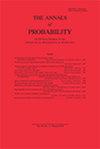树形青蛙模型的递归性和暂态性
IF 2.5
1区 数学
Q1 STATISTICS & PROBABILITY
引用次数: 61
摘要
青蛙模型是一个随机游走的生长系统,每当一个新的地点被访问时,就会添加一个粒子。一个长期存在的开放性问题是,无限任意树的根被访问的频率是多少。我们证明了模型经历了一个相变,当d=2d=2时它是周期性的,当d≥5d≥5时它是瞬态的。模拟结果表明,d=2d=2时强递归,d=3d=3时弱递归,d≥4d≥4时瞬态。此外,我们证明了一个0-1定律适用于所有的任意树,并展示了一个0-1定律不成立的图。为了证明当d=2d=2时的递归性,我们构造了一个较小过程中对根的访问次数的递归分布方程,并证明了唯一解必须是无限的。当d=5d=5时的暂态性的证明依赖于计算机计算一个大马尔可夫链的转移概率。我们还包括d≥6d≥6的证明,它使用类似的技术,但不需要计算机辅助。本文章由计算机程序翻译,如有差异,请以英文原文为准。
Recurrence and transience for the frog model on trees
The frog model is a growing system of random walks where a particle is added whenever a new site is visited. A longstanding open question is how often the root is visited on the infinite dd-ary tree. We prove the model undergoes a phase transition, finding it recurrent for d=2d=2 and transient for d≥5d≥5. Simulations suggest strong recurrence for d=2d=2, weak recurrence for d=3d=3, and transience for d≥4d≥4. Additionally, we prove a 0–1 law for all dd-ary trees, and we exhibit a graph on which a 0–1 law does not hold. To prove recurrence when d=2d=2, we construct a recursive distributional equation for the number of visits to the root in a smaller process and show the unique solution must be infinity a.s. The proof of transience when d=5d=5 relies on computer calculations for the transition probabilities of a large Markov chain. We also include the proof for d≥6d≥6, which uses similar techniques but does not require computer assistance.
求助全文
通过发布文献求助,成功后即可免费获取论文全文。
去求助
来源期刊

Annals of Probability
数学-统计学与概率论
CiteScore
4.60
自引率
8.70%
发文量
61
审稿时长
6-12 weeks
期刊介绍:
The Annals of Probability publishes research papers in modern probability theory, its relations to other areas of mathematics, and its applications in the physical and biological sciences. Emphasis is on importance, interest, and originality – formal novelty and correctness are not sufficient for publication. The Annals will also publish authoritative review papers and surveys of areas in vigorous development.
 求助内容:
求助内容: 应助结果提醒方式:
应助结果提醒方式:


